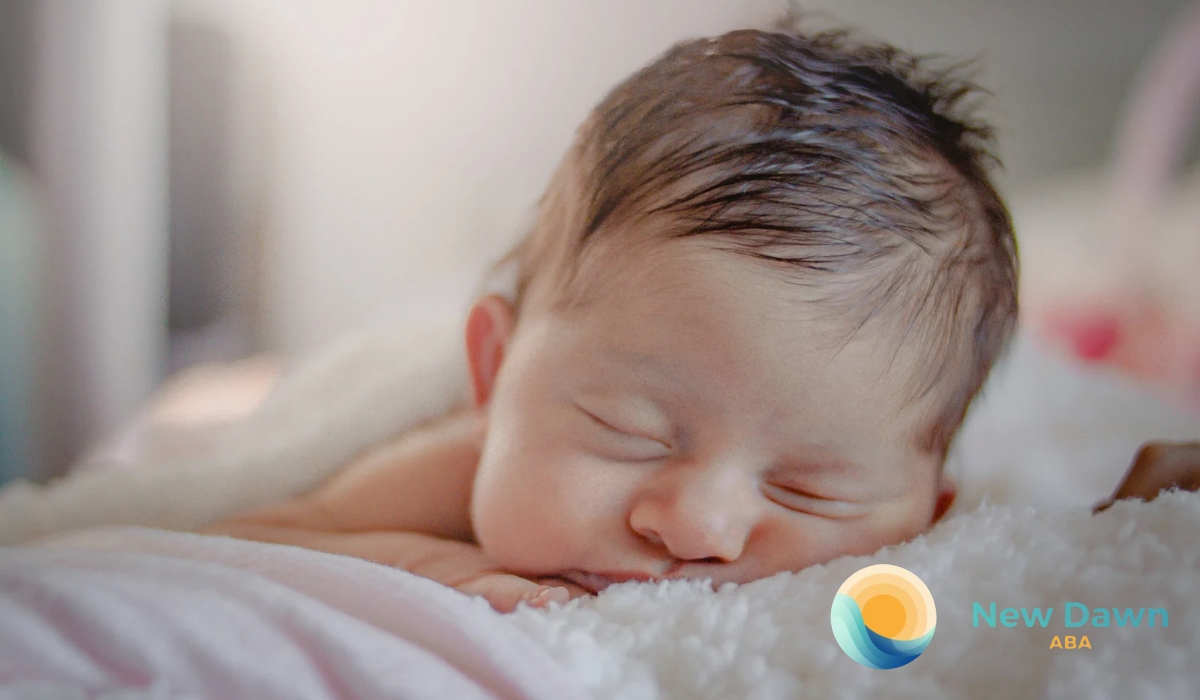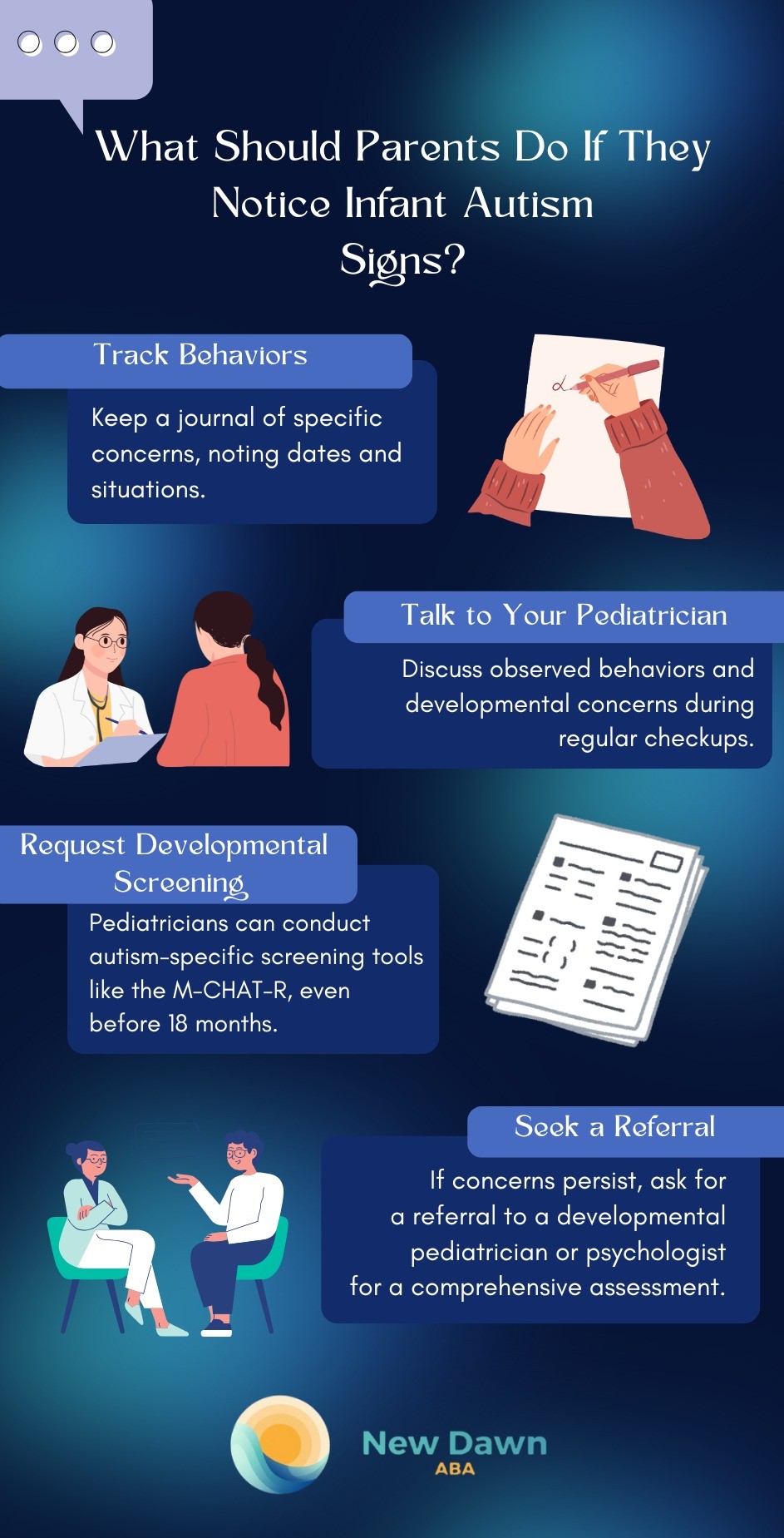Key Points:
- Early detection of autism can begin as young as 6 to 12 months, with subtle signs noticeable in social and communication development.
- Recognizing the "early signs of autism in infants" symptoms helps parents seek appropriate evaluation and support sooner.
- Lack of eye contact, delayed babbling, and limited social engagement are common red flags to monitor.
Welcoming a new baby is filled with milestones—first smiles, first sounds, first moments of connection. But what happens when some of these expected developmental signs don’t appear as anticipated? For many parents, subtle differences in how their baby interacts or responds may raise questions. Is this just a phase? Or could it be something more?
Understanding the early signs of autism in infants is a crucial step in ensuring children get the support they need as early as possible. Autism Spectrum Disorder (ASD) affects social communication and behavior, and its earliest symptoms often show up in infancy. While every child is unique, being aware of early developmental differences can help parents take action with confidence and care.
Can Autism Be Detected In Infancy?
Yes, autism can show early signs in infancy, although a formal diagnosis typically occurs between 18 months and 3 years. Research and clinical experience show that some behavioral and developmental signs can be observed as early as 6 months of age. Recognizing the early signs of autism in infants allows for earlier intervention, which is known to significantly improve long-term outcomes.
Parents are usually the first to notice when something seems different, especially when a baby doesn’t follow typical patterns of social development. These early signs may be subtle and often misunderstood as quirks or delays that will correct over time. While some babies may simply develop at a slower pace, persistent signs—especially when multiple occur together—warrant a closer look.

Common Early Signs of Autism in Babies
While autism presents differently in each individual, there are several early red flags that can suggest a child might be on the spectrum. These behaviors often relate to social interaction, communication, and repetitive behaviors. Recognizing these early differences can guide caregivers to seek early evaluation and support.
1. Limited Eye Contact
Most babies start to make eye contact in the initial weeks after birth. If a baby regularly avoids looking at people’s eyes, even during moments like feeding or when someone smiles at them, it could be an early sign of autism.
2. Lack of Social Smiling
Most babies begin social smiling by 6 to 8 weeks. If a baby rarely smiles back when smiled at or doesn’t respond to social interaction with facial expressions, it can be a sign of reduced social engagement.
3. Delayed or Absent Babbling
Babbling is a key precursor to speech and typically starts around 6 months. Babies who are not cooing, babbling, or experimenting with sounds may be exhibiting a communication delay, often seen in early signs of autism.
4. Doesn’t Respond to Name
By 6 to 12 months, babies usually respond to their name being called. If a baby consistently doesn’t turn or react when their name is spoken, it might suggest difficulty with auditory processing or social responsiveness.
5. Poor Eye-Following or Tracking
Infants naturally begin to follow objects or people with their eyes by 2 to 3 months. Difficulty with visual tracking or a lack of interest in observing others may indicate a developmental difference.
6. Repetitive Movements
Early repetitive behaviors such as hand flapping, rocking, or spinning objects may be observed before age 1. While some repetition is typical in babies, the intensity and frequency can help distinguish autism-related stimming behaviors.
7. Limited Gestures
By 9 to 12 months, babies usually begin pointing, reaching to be picked up, or waving “bye-bye.” A lack of these nonverbal communication skills may be a significant marker in identifying early autism cases.
8. Preference for Objects Over People
Some babies with autism may show a stronger interest in objects, lights, or spinning items rather than interacting with people. This difference in attention can be seen during playtime or routine activities.
What Should Parents Do If They Notice Infant Autism Signs?
Noticing one or two signs doesn’t necessarily mean a baby has autism. However, consistent patterns across multiple areas—especially social communication and engagement—should prompt further evaluation.
If a parent or caregiver is concerned, early action can make a significant difference. Here's what to do:

Why Early Detection Matters
Early intervention is widely recognized as one of the most effective ways to support children with autism. Therapies introduced during the first few years of life—when the brain is most adaptable—can significantly enhance language development, social skills, and cognitive abilities.
Understanding the early signs of autism in infants empowers families to seek services that meet their child’s unique needs, rather than waiting and risking potential delays in progress. Even if a diagnosis isn’t made immediately, support strategies can still be beneficial.
Supporting Development at Home
While seeking professional support is essential, parents can also foster social and communication development at home. Engaging in responsive interactions helps babies feel connected and supported. Here are practical ways to encourage development:
- Face-to-Face Play: Spend time making faces, smiling, and talking directly to your baby.
- Narrate the Day: Talk about what’s happening around the baby to build language exposure.
- Imitate Sounds and Gestures: Respond to your baby’s sounds or movements to show that communication is a two-way exchange.
- Sing Songs and Use Rhymes: Rhythmic patterns are enjoyable and can support early language learning.
- Use Visuals and Gestures: Point to objects and use simple gestures like waving or clapping to model communication.
When Is A Diagnosis Usually Made?
Although early signs can be noticed by 6 to 12 months, most children are formally diagnosed around age 2 or later. However, early signs give caregivers an opportunity to begin learning, planning, and engaging with early intervention resources, even before a full diagnosis is given.
By keeping a close eye on developmental milestones—and trusting their instincts—parents are often the first and most powerful advocates for their child’s needs.
Start Your Journey With Expert Support
If you've recognized the early signs of autism in infants and are wondering what the next steps should be, New Dawn ABA is ready to support your family with evidence-based, compassionate care. Specializing exclusively in Applied Behavior Analysis (ABA), we focus on helping children with autism build vital communication, social, and functional life skills.
Our team offers ABA therapy in Colorado and Missouri, working closely with families to create personalized plans that meet each child where they are. Whether you’re still seeking answers or already navigating the early stages of diagnosis, our goal is to empower you and your child with tools that make a real difference.
Contact us today to learn more about how our tailored ABA therapy services can support your child’s developmental journey. Early action brings lifelong benefits—and you don’t have to walk this path alone.
Recent articles

At New Dawn ABA, we believe in brighter beginnings. Our team partners with families to build skills that matter—turning daily moments into meaningful progress and long-term independence.

.svg)
.svg)
.svg)
Quick Links
HomeAbout UsServicesLocationsResourcesCareersContact UsPrivacy PolicyOur Locations
MissouriColoradoKansas (Coming Soon)Oklahoma (Coming Soon)Contact Information
.png)
720-784-4944
.png)
720-784-4945
.png)
info@newdawnaba.com
Copyright © 2025 New Dawn ABA - All Rights Reserved.




